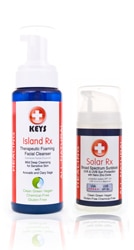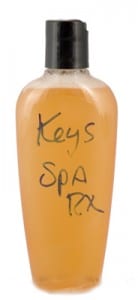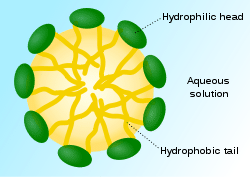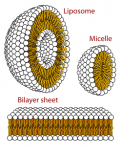Acne Solutions…Cause and Effect!
Acne Solutions. Real or Unreal?

By Bob Root, Keys Technologist
There are many acne treatments on the market promising a quick result. They work quickly and as quickly, the skin rebounds, for most with, with a vengeance.
We receive a lot of emails from people wondering what we have for treating acne. Ironically, Keys is in business because of acne treatment. More about that later.
The major quick fix for acne has been the same since the 1920’s. The chemical is called Benzyol Peroxide. Benzoyl peroxide is an compound in the organic peroxide family. It consists of two benzoyl groups joined by a peroxide group. Benzoyl peroxide is used as an acne treatment, for improving flour, for bleaching hair and teeth, for polymerising polyester and many other uses.
 Jack Breitbart of Revlon laboratories first developed the use of benzoyl peroxide for treating acne in the 1920’s. It is typically placed over the affected areas in gel or cream form, in concentrations of 2.5% increasing through the usually effective 5% to up to 10%. Research suggests that 5 and 10% concentrations are not significantly more effective than 2.5% and 2.5% is usually better tolerated. It commonly causes initial dryness and sometimes irritation, although the skin develops tolerance after a week or so. A small percentage of people are much more sensitive to it and liable to suffer burning, itching, peeling and possibly swelling. It is sensible to apply the lowest concentration and build up as appropriate. Once tolerance is achieved, increasing the quantity or concentration a second time and gaining tolerance at a higher level usually gives better subsequent acne clearance. Benzoyl peroxide works as a peeling agent, increasing skin turnover and clearing pores, thus reducing the bacterial count there as well as directly as an antibacterial. (Wikepedia)
Jack Breitbart of Revlon laboratories first developed the use of benzoyl peroxide for treating acne in the 1920’s. It is typically placed over the affected areas in gel or cream form, in concentrations of 2.5% increasing through the usually effective 5% to up to 10%. Research suggests that 5 and 10% concentrations are not significantly more effective than 2.5% and 2.5% is usually better tolerated. It commonly causes initial dryness and sometimes irritation, although the skin develops tolerance after a week or so. A small percentage of people are much more sensitive to it and liable to suffer burning, itching, peeling and possibly swelling. It is sensible to apply the lowest concentration and build up as appropriate. Once tolerance is achieved, increasing the quantity or concentration a second time and gaining tolerance at a higher level usually gives better subsequent acne clearance. Benzoyl peroxide works as a peeling agent, increasing skin turnover and clearing pores, thus reducing the bacterial count there as well as directly as an antibacterial. (Wikepedia)
There are a couple of significant points in the above observation.
- The skin reacts and a tolerance level must be built.
- Sensitive skin has even greater reactions and might be more unsightly than the acne.
- Dosage must increase to be effective.
- The Benzoyl Peroxide acts on bacteria
There was a poll conducted on one of the acne sites asking how many people have a reoccurrence of acne after a period of time while still on a treatment program. 94% saw a recurrence equal to or greater than before.

We started in the acne business in a strange sort of way. Yes, Wendy’s skin reactions caused me to develop a soap for her that was deep cleaning, affected what was going on with her skin disorders and dealt with her sensitive skin. It would almost seem contra possible in our chemical world, but the sciences come to bat quickly when it comes to being able to deep clean and not irritate the skin.
For Wendy and the 200+ attempts to formulate Island Rx Castile Soap was both experimental and pushing back time to ancient remedies. Every day we read about how some old recipes are solving new problems. For Wendy, post Melanoma cancer recovery found her skin with all sorts of disorders including adult acne. We have now traced all of that back to parabens, glycols, chemical sunscreen ingredients and benzoyl peroxide. Yes, benzoyl peroxide!
Wendy’s skin began to stabilize when she started using Island Rx and got off the chemical junk. It actually started to improve when we took her off of the junk and started her using Dr Bronner’s Peppermint Castile soap. I guess you could say that Dr Bronner put us in business, because if their soap had done the trick, I would not have set off to make our own. Wendy found it too harsh and alkaline for her post cancer recovery super sensitive skin.
I thought three things.
- Getting her off the junk was the first step
- Something in Dr Bronner’s worked
- Wendy’s skin was too sensitive to the Dr Bronner product
So, when I began to formulate, I had three challenges that mirrored the observations
- Make a product that would not cause a reaction to Wendy’s skin
- It had to work with lasting results
- It could not contain any of the chemicals that we traced as the cause of her skin disorders. Chemical burns!
Again, we did not set out to build a product company, be ranked number one by the www.safecosmetics. org or focus on morphing our technology consulting business into a natural products company. I was just trying to develop something that worked for Wendy.

Before I explain how it works, let me explain the acne connection. Our European technology friends visiting had a chance to use Island Rx when it was in our guest bathroom in a clear bottle labeled with a Sharpie marker. We began to give them bottles to take home. Many of them had kids, friends or relatives that were suffering from acne and it began to work. Our friend Brian from the UK, urged us to improve the labeling using his British humor. When we decided to test market 250 bottles in Key West, a few months later, we began to receive reports back that a large percentage of people found results for their acne with little to no recurrence. That was the acne connection and Island Rx continues to be a preferred solution by many adults and young people experiencing acne and “bacne.”
The connection to having deep cleaning effects and still maintaining sensitive skin is contra-principles if you think like a chemist striving for fast results. Scientifically it is actually more of a natural occurrence. For example, we now take for granted that enzymes work better in many types of cleaning products than chemical based surfactants. We also take for granted probiotics flora for the gut and that the components of gluten affect one in every one hundred. So is true of why Solar Rx works for acne and other chemical based skin disorders.
So to understand, we have to dissect how and why we created Island Rx the way we did. The base recipe of Island Rx began over 400 years ago in the Castile region of Spain. This was the origin of Dr Bronner’s soap, Ivory soap bars and Keys Island Rx. Then, they would take a rough olive oil and Saponified it using ash from wood fires. The original inventors noted when mixed with water, this concoction would bubble and facilitate cleaning of the skin and clothing.
A few thousand years before that, ancients discovered that oils from plants and their seeds would protect their skin from sun exposure and some actually improved skin appearance. Ancients like Cleopatra paid huge sums for these exotic oils and thus started the first cosmetics salesman and marketers. Like today, most almost worked.
When we developed Island Rx, we used some olive oil and other oils to saponify them to lower the Ph. What we did not realize at the time was that our methodology would create high levels of Micellae in the process. These Micellae are the deep cleaning agent of Island Rx that actually “carry” other essential oils deep into the skin without the irritation of a chemical surfactant or benzoyl peroxide.
I get dinged by our marketers for being too technical, but Micellae are interesting characters that somewhat resemble enzymes. Much cancer research now points to Micellae as potential transporters of single cell cancer fighters. They offer Keys the same transport function deep into the skin carrying essential oil to do the work without the irritation.
From Wikepedia comes one of the best descriptions of a Micelle. Keep in mind as you read the below and explore the rest of the link, that what we figured out by accident was that our version of a Castile soap contained as much as 3X the Micellae.
From Wikepedia

A micelle , plural micelles, micella, or micellae) is an aggregate of surfactant molecules dispersed in a liquid colloid. A typical micelle in aqueous solution forms an aggregate with the hydrophilic “head” regions in contact with surrounding solvent, sequestering the hydrophobic single tail regions in the micelle centre. This phase is caused by the insufficient packing issues of single tailed lipids in a bilayer. The difficulty filling all the volume of the interior of a bilayer, while accommodating the area per head group forced on the molecule by the hydration of the lipid head group leads to the formation of the micelle. This type of micelle is known as a normal phase micelle (oil-in-water micelle). Inverse micelles have the headgroups at the centre with the tails extending out (water-in-oil micelle). Micelles are approximately spherical in shape. Other phases, including shapes such as ellipsoids, cylinders, and bilayers are also possible. The shape and size of a micelle is a function of the molecular geometry of its surfactant molecules and solution conditions such as surfactant concentration, temperature, pH, and ionic strength. The process of forming micellae is known as micellization and forms part of the phase behavior of many lipids according to their polymorphism (Here is a link to the rest of the article.)

In our studies of ancient remedies, we found that some of the most powerful yet gentle skin agents were Clary sage, blood orange, black cumin (black seed) oil, carrot seed oil and avocado oil. When use on the skin in lotions or soap, they perform the same as some harsh chemicals in a slow but sure manner.
So, how does all this work to help acne suffers? We have found through our customers that they have developed a sort of regime that makes perfect sense to me.
First, they get off all the junk and go clean including shampoo, personal care and home care products. You probably already get this because you are reading this. Then they wash daily with Island Rx foaming wash, rinsing and lightly drying. In the morning (some twice a day) they apply Solar Rx. Yes, the sunblock. Solar Rx contains pharmaceutical grade avocado oil, back cumin oil, carrots seed oil and uncoated zinc oxide. Those powerful essential oils sooth the skin and mimic the skins own sebum restoring good oil levels lost by being exposed to hydrocarbons, pollutants, dryness and dehydration. The uncoated zinc oxide is at 18.5% by volume. Most zinc oxide based acnes and skin prescriptions only contain 5%-6% uncoated zinc oxide. They discovered that they can get the same pharma grade zinc oxide in Solar Rx at much higher levels and at a fraction of the price of prescription creams.

The combination of Island Rx and Solar Rx have shown to work for many of our customers. Said, that critical word, Bacteria, is important here. We believe that the majority of acne and bacne have two origins. Yeast and bacteria. We believe that many chemicals, including Benzoyl Peroxide, kill off bacteria so quickly that natural forming yeast runs rampant. Attempts to use chemical agents mixed with Benzoyl Peroixide to kill the yeast as well seem to work for a short time, but then other forms of bacteria and gram positive rods like eColi and Staph can enter and affect the skin with much worse reactions. Why we believe that the regime of Island Rx and Solar Rx work is because they maintain a good balance of bacteria and yeast on the skin. For the same reason we take probiotics, the Micellae and essential oils in our products promote a healthy balance.

I certainly hope that we help some if not all, but it will take time. We believe the quick fixes in solving skin disorders may be quick, but they are not fixes.
Parting shot is that we also find that most of the acne suffers we talk to are clinically dehydrated. For normal people, 8-10 glasses of water a day maintains. For the clinically dehydrated, a few weeks of two gallons a day is need to get back to normal. Now the secret, for many acne suffers, becoming properly hydrated does the trick to reverse the disorder. Island Rx and Solar Rx will help along the way.